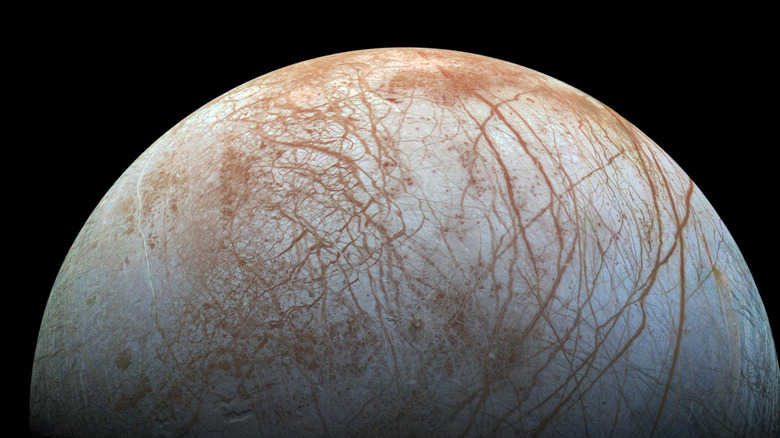The Mystery Of Europa's Geysers
Geysers can be fascinating to watch. For example, Steamboat Geyser at Yellowstone Park is always a popular destination for tourists. The huge spurts of steam and water almost never fail to solicit "oohs" and "ahhs" from those who are watching it. The geyser is caused by overheated water that has been pressurized through a small opening, and the result can be a plume of steam and smoke that can reach as high as 300 feet, per the National Park Service.
Earth is far from the only object in the solar system that features geysers. According to Windows2Universe, one of Jupiter's moons, Io, shows geyser activity, and so does Enceladus, one of Saturn's moons. Another moon of Jupiter, Europa, is the one that we want to focus on here, given that the plumes are coming out from thick ice. That is a find that has piqued the interests of astronomers worldwide.
The Europa geysers were more of a theory at first, but per EarthSky, on November 18, 2019, observers saw water vapor that was above the moon, which was a sign of geyser activity. Other instruments like the Hubble Telescope and a spectrograph used at the W.M. Keck Observatory, situated at Mauna Kei in Hawaii, have detected signs of water vapor, which would be in an amount that could fill an Olympic swimming pool. This is impressive, and very promising, since there is an ocean underneath the Jovian moon's ice crust. Life could be under that ice in the water.
Who knows what mysteries lie under Europa's surface?
Unfortunately, unlike a more regular geyser at Yellowstone — Old Faithful — Europa's theoretic geysers are irregular. Per EarthSky, they are also faint. That makes for hard viewing, since it is not known when one might spurt. It is a very enticing mystery, though, and hopefully humanity will be able to observe it more to find out about the moon and what lies beneath its thick layers of ice. The big mystery is where the plumes are coming from ... and whether they actually exist or not, since the evidence is not 100% conclusive.
That ability to learn more about Europa and what is surrounding it will happen sooner than later — per NASA, there is a probe mission launching in 2024 called the Europa Clipper, which is supposed to take readings on the moon when it reaches it. Part of this is to examine whether the water is able to sustain life, which they do believe it can, and they will be examining the plumes. Astronomers can get the data from the Clipper and then help chart the objectives of further missions to see if more in-depth exploration of Europa's ocean is needed.
The ultimate goal here is to be able to find other life in space and learning more about Europa's geysers and the places from which it springs from. This could be a big discovery to learn a lot more or it could be a disappointment. Either way ... that's science.

